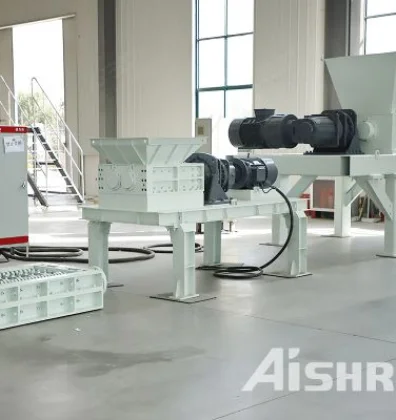The disposal and recycling of waste tires have become crucial environmental concerns worldwide. One effective approach is the utilization of a double-shaft shredder to process waste tires and convert them into rubber powder. This article aims to discuss the optimization of the double-shaft shredder’s operation for the efficient production of high-quality rubber powder.
Selection of Shredder Parameters
To achieve optimal results, several key parameters of the double-shaft shredder should be considered:
- Shredder Speed: Adjusting the speed of the shredder blades ensures the proper size reduction without excessive energy consumption.
- Blade Configuration: Choosing the appropriate blade design and spacing enhances the shredding efficiency and minimizes the generation of excess heat.
- Shredder Capacity: Ensuring the shredder's capacity matches the throughput requirements guarantees smooth and continuous tire processing.

Tire Preparation
Effective tire preparation is essential for maximizing the shredder's performance:
- Tire Debeading: Prior to shredding, removing the steel beads from the tire sidewalls reduces blade wear and minimizes damage to the shredder.
- Size Reduction: Reducing the tire size into manageable pieces facilitates the shredding process and improves overall efficiency.
Shredding Process
The shredding process itself plays a vital role in achieving optimal production of rubber powder:
- Uniform Feeding: Maintaining a consistent and even flow of tires into the shredder prevents overloading and ensures efficient shredding.
- Cross-Cutting Action: The double-shaft shredder's unique design enables a thorough and uniform cutting action, resulting in a more consistent rubber powder output.
- Temperature Control: Monitoring and controlling the shredder's operating temperature helps prevent excessive heat generation, ensuring the quality of the rubber powder.
Sieving and Separation
After the tires have been shredded, sieving and separation techniques are employed to obtain refined rubber powder:
- Vibratory Sieves: Utilizing vibratory sieves removes larger particles, ensuring the final rubber powder meets the required specifications.
- Magnetic Separators: Employing magnetic separators helps eliminate any remaining steel or iron fragments from the rubber powder.
Quality Assurance
To ensure the production of high-quality rubber powder, certain quality control measures should be implemented:
- Particle Size Analysis: Regularly analyzing the particle size distribution verifies that the rubber powder meets the desired specifications.
- Material Testing: Conducting material tests, such as tensile strength and elastomer properties, ensures the rubber powder's suitability for various applications.
- Environmental Compliance: Adhering to environmental regulations during the shredding and powder production processes minimizes any potential negative impacts.

Proper optimization of the double-shaft shredder's operation is crucial for efficiently processing waste tires into high-quality rubber powder. Through careful consideration of the shredder parameters, tire preparation, shredding process, sieving and separation techniques, and quality assurance measures, the production of valuable rubber powder can be maximized while minimizing environmental impact.




